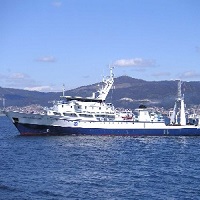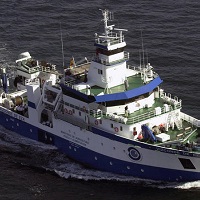Keyword
38
12 record(s)
Type of resources
Categories
Topics
INSPIRE themes
Keywords
Contact for the resource
Provided by
Years
Formats
Status
-

ATLOR 1/1972. All measurements were made underway
-

Sahara 1/1971. All measurements were made underway
-
This cruise is part of the UK science contribution to the international SOLAS project (Surface Ocean Lower Atmosphere Study www.uea.ac.uk/env/solas/) which aims to advance our understanding of environmentally important interactions between the ocean and the atmosphere. Data collected during the cruise will help to determine the influence of coastal/shelf regions (20-200 km offshore) on microbiological activity in the ocean and chemical interactions between the ocean and the atmosphere. Deep water containing high concentrations of nutrients such as nitrate, and gases such as nitrous oxide and methane, rises to the surface (upwells) at the Mauritanian shelf edge and moves offshore. These nutrients can be chemically altered by sunlight and used by bacteria and microscopic plants to grow. The gases escape to the atmosphere and contribute to global warming. This cruise will sample the upwelled water as it moves offshore measuring its temperature, salinity, nutrient and gas content and the impact this water has on microbiological growth and atmospheric composition in order to improve international global climate models. The cruise has three scientific objectives: 1. To determine the role of upwelling on the supply, loss and air-sea exchange of climatically important gases produced by plankton 2. To determine the role of light in breaking down upwelled and recently produced dissolved organic matter and in producing climatically important trace gases 3. To determine the impact of nutrient enriched upwelled water on the spatial and temporal variability of plankton community structure and activity and resultant influence on biogenic gas flux
-
Objectives: To quantify marine halocarbon emission variability and latitudinal variation, characterise in situ open ocean atmospheric reactive iodine latitudinal variability and characterise oxidative chemistry perturbation due to oceanic emission of halogens from the Mauritanian upwelling region. Rationale: Transecting from the UK through Biscay, south past the west coast of Africa, through the Mauritanian upwelling, to pass Cape Verde simultaneous to the intensive deployment at the UK SOLAS Observatory on Sao Vicente, the measurements made on Discovery cruise D319 are intended to provide a detailed latitudinal characterisation of marine atmospheric halogen chemistry. This will feed validation and constraint data to regional and global models in projects linked to RHaMBLe. In addition the cruise will address a number of key scientific questions required to determine the global importance of iodine chemistry and to further our understanding of the controls of halogen chemistry in the remote ocean: i) How heterogeneous are the direct halogen sources and on what scale is the heterogeneity - does the upwelling region produce more or less halogens than the 'background' region? ii) What are the relative contributions of I atoms to the remote MBL from I2 and organic iodine? iii) Is sufficient iodine released to the remote MBL to sustain aerosol nucleation or to significantly affect the ozone budget and free radical populations? Measurement Description: Measured species included a variety of halocarbons in both water column and atmosphere and atmospheric boundary layer measurements of I2, OIO and IO by Broadband Cavity Enhanced Absorption Spectroscopy (BBCEAS). A compact version of the FAGE system, developed for the FAAM BAe-146, was deployed to provide measurements of IO or OH / HO2, permitting direct assessment of RHS-induced changes in the oxidising environment through the upwelling region. A range of trace gas monitors was simultaneously deployed to measure O3 and NOx. Aerosol number and size distribution measurements from 3 nm to 20 micron diameter were also made by a range of mobility (SMPS) and optical instrumentation, (OPC and FSSP). Additional aerosol measurements were provided as part of the NERC-funded ACMME project (PI Allan). Measurements of pigments in the surface waters were made by HPLC. Prevailing meteorological conditions were used to direct the cruise in terms of geographical positioning and measurement interpretation, e.g. i) exploitation of any broad flow connection between Cape Verde and the ship to interpret measurements as process studies and ii) identification of in- and out-of-plume conditions to contrast chemistry influenced and uninfluenced by emissions from the upwelling region.
-
The main testable hypothesis of the proposed work is: Atmospheric inputs control rates of primary production and microbial diversity in oceanic waters where nutrients are limiting. The objectives of the project are to: 1. Obtain an improved temporal and spatial estimate of atmospheric dust inputs to the tropical N Atlantic through collections on a dedicated SOLAS process cruise. 2. Obtain an improved estimate of the seawater dissolution of N, P, Fe and Zn species from aerosol dust. 3. Determine the impact of atmospheric dust derived micronutrients on microbial community production and species diversity in the surface microlayer and underlying waters. In addition, researchers from the Archer/Geider group were on-board. The overall aim of their research was to determine the extent to which the photoprotective roles of DMSP and QAs influence their production rates in marine surface waters and hence, the production of their volatile breakdown products. The cruise objectives for this work were to: 1. relate DMSP and QAC concentrations to plankton community structure, light regime, photoinhibition, xanthophyll cycle and MAA accumulation in varying oceanic provinces and over diel cycles. 2. determine the potential for photoinhibition and DMSP/GBT turnover in natural phytoplankton in contrasting oceanic provinces. The cruise departed Tenerife on February 5, 2008, and we have conducted regular stations (typically 2 per day) along the cruise track. The track took us into the oligotrophic Atlantic waters, productive Cape Verde waters, and tropical waters with very high nitrogen fixation (judged initially from the Trichodesmium concentrations). The various researchers and groups have also started a range of biological experiments at different sites along the cruise track. We have encountered a major dust event in week 2, and then from week 3 of the cruise we encountered large amounts of dust. We have visited the TENATSO time series site near the Cape Verdes and have undertaken an extensive set of measurements there. We have collected the atmospheric dust for elemental analyses (at UEA and NOCS), and also to produce leachates which are used on board for biological experiments. We have undertaken sampling of the water column to analyse for dissolved and particulate metals, nutrients, dissolved organic matter, amino acids, hemes, thiols and phytochelatin synthase expression. In addition, nitrogen fixation measurements were undertaken, in tandem with nifh gene sampling. Nitrate uptake experiments have been conducted. Furthermore, bacterial phosphate uptake experiments have been undertaken using addition of collected dust. Halocarbon and DMS gas measurements have been conducted during the cruise. In addition, experiments have been undertaken by the Archer/Geider group on effects of high sun light exposure on DMS and GBT production. The cruise has been very successful with a minimum of lost time.
-

Evaluation of the sea floor by indirect and direct methods.
-

Sahara 2/1971
-

CINECA II (August-1973)
-

Data collection is also collected for several other demersal fish species and invertebrates.
-
The cruise D361 forms part of a study entitled 'Physical and chemical forcing of diazotrophy in the (sub)-tropical Atlantic Ocean'. The study is investigating the potential influence of iron and phosphorus availability on nitrogen fixation in regions of the tropical Atlantic Ocean. The cruise also undertakes deep trace metal clean CTD casts as part of the International GEOTRACES programme. The purpose of the cruise therefore is to undertake measurements of dissolved and particulate iron and phosporpus availability, their spatial and temporal variations, and their impact on diazotrophy in the surface ocean. Aim: To quantify the supply and determine the biogeochemical cycling of Fe and other nutrients, and relate this to N2 fixation, diazotroph species distribution and N* fields. 1. Quantify the distribution of nutrients and trace metals: Quantify surface water and water column distributions of dissolved inorganic/organic N, P, Fe, and DAl, DMn and particulate P, N, Fe, Al, Mn. 2. Quantify the rate of Fe, Al, Mn, P and N supply to surface waters: Assess the source fluxes of the key elements for diazotrophs and source tracers to the surface ocean from atmospheric deposition and internal transport via diapycnal mixing and lateral advection. 3. Identify the source of subsurface Fe enrichment: Identify whether Fe-rich subsurface waters of the tropical North Atlantic thermocline originate from the atmosphere or the shelf using Fe distributions and Al, Mn, and O2 source tracers. 4. Quantify the diazotrophic response to Fe, phosphate, DOP supply: Relate the spatial distributions of inorganic Fe and organically complexed Fe, and phosphate and DOP to diazotrophy. The specific uptake of Fe, phosphate and DOP by the whole microbial community and Trichodesmium will be assessed by shipboard incubations, radiotracer techniques and enzyme bioassays. In addition, we will identify the connection between N2 fixation rates and diazotroph community structure, by comparing size fractionated 15N2-derived rates of N2 fixation (Fig. 1) with abundance and diversity of diazotrophs using nifH phylogeny. Objective 5: Investigate how the large scale transport pathways of Fe and P influence the N* distribution: Use fine-scale isopycnic model to reveal the large-scale transport pathways of Fe and P in the (S)-T Atlantic, and their effect on the N* distribution.
 Catálogo de datos del IEO
Catálogo de datos del IEO